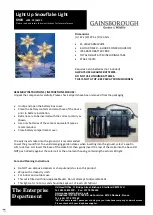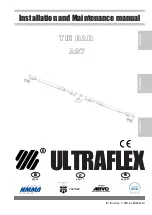
PREFACE
[
I
]
• Employers are responsible for identifying all job site hazards, educating and training all persons who will operate and
maintain these products, and ensuring that all blast operators and their assistants understand the warnings and
information contained in these instructions relating to safe and proper operation and maintenance of this equipment.
• Serious injury or death can result from failure to comply with all Occupational Safety and Health Administration
(OSHA)regulations and all manufacturer’s instructions.
• This equipment is not intended for use in any area considered hazardous per National Electric Code NFPA 70 2011,
Article 500.
• Read this document and follow all instructions before using this equipment.
OSHA regulations relating to abrasive blasting are contained in the Code of Federal Regulations, Title 29 (29 CFR 1910 General Industry;
1915 Maritime; 1926 Construction). The most pertinent include: 1910.94 Ventilation, 1910.95 Occupational Noise Exposure, 1910.132
Personal Protective Equipment, 1910.133 Eye and Face Protection, 1910.134 Respiratory Protection, 1910.135 Head Protection,
1910.244 (b) Remote Controls. Consult www.osha.gov for complete information.
NOTICE TO PURCHASERS AND USERS OF OUR
PRODUCTS AND THIS INFORMATIONAL MATERIAL
Clemco proudly provides products for the abrasive blast
industry and is confident that industry professionals will use
their knowledge and expertise for the safe and efficient use of
these products.
The products described in this material, and the information
relating to these products, are intended for knowledgeable,
experienced users.
No representation is intended or made as to: the suitability of
the products described here for any purpose or application, or
to the efficiency, production rate, or useful life of these
products. All estimates regarding production rates or finishes
are the responsibility of the user and must be derived solely
from the user’s experience and expertise, not from information
contained in this material.
It is possible that the products described in this material may
be combined with other products by the user for purposes
determined solely by the user. No representations are
intended or made as to the suitability of or engineering
balance of or compliance with regulations or standard practice
of any such combination of products or components the user
may employ.
Abrasive blast equipment is only one component of an
abrasive blasting job. Other products, such as air
compressors, air filters and receivers, abrasives, scaffolding,
hydraulic work platforms or booms, equipment for lighting,
painting, ventilating, dehumidifying, parts handling, or
specialized respirators or other equipment, even if offered by
Clemco, may have been manufactured or supplied by others.
The information Clemco provides is intended to support the
products Clemco manufactures. Users must contact each
manufacturer and supplier of products used in the blast job for
warnings, information, training, and instruction relating to the
proper and safe use of their equipment.
GENERAL INSTRUCTIONS
This material describes some, but not all, of the major
requirements for safe and productive use of blast machines,
remote controls, respirator systems, and related accessories.
All equipment and accessories must be installed, tested,
operated and maintained only by trained, knowledgeable,
experienced users.
The blast operator and all workers in the vicinity must be
properly protected from all job site hazards including those
hazards generated by blasting.
Work environments involving abrasive blasting present
numerous hazards. Hazards relate to the blast process from
many sources that include, but are not limited to, dust
generated by blasting or from material present on the surface
being blasted. The hazards from toxic materials may include,
but are not limited to, silica, cyanide, arsenic, or other toxins
in the abrasives or in the coatings, such as lead or heavy
metals. Other hazards from toxins include, but are not limited
to, fumes from coating application, carbon monoxide from
engine exhaust, contaminated water, chemicals or asbestos.
In addition, physical hazards that may be present include, but
are not limited to, uneven work surfaces, poor visibility,
excessive noise, and electricity. Employers must identify all
job site hazards and protect workers in accordance with
OSHA regulations.
Never modify Clemco equipment or components or
substitute parts from other manufacturers for any Clemco
components or parts. Any unauthorized modification or
substitution of supplied-air respirator parts violates OSHA
regulations and voids the NIOSH approval.
IMPORTANT
Contact Clemco for free booklets:
Blast Off 2 – Guide to Safe, Productive, and Efficient Abrasive
Blasting, and Abrasive Blasting Safety Practices – Guide to Safe
Abrasive Blasting.
Clemco Industries Corp. One Cable Car Drive Washington MO 63090
Tel: 636 239-4300 — Fax: 800 726-7559
Email: [email protected]
Website: www.clemcoindustries.com




























